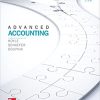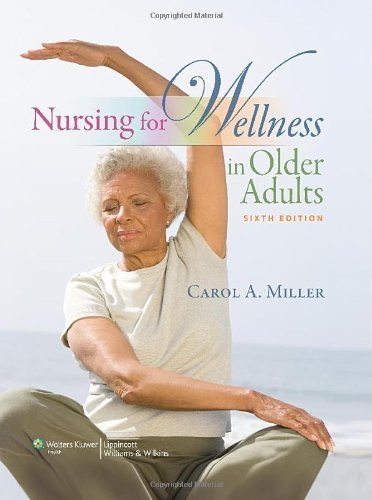Nursing for Wellness in Older Adults Miller 6th Edition Test Bank
$35.00 Original price was: $35.00.$26.50Current price is: $26.50.
Nursing for Wellness in Older Adults Miller 6th Edition Test Bank
Instant download Nursing for Wellness in Older Adults Miller 6th Edition Test Bank pdf docx epub after payment.
Test Bank for Nursing for Wellness in Older Adults Sixth
Edition by Miller
Chapter 1: Seeing Older Adults Through The Eyes Of Wellness
1. The nurse is discussing an older adult’s recent diagnosis of rheumatoid
arthritis with a colleague. Which of the nurse’s statements reflects an
accurate view of the relationship between aging and wellness?
A) “It’s important that the individual knows this is an expected part
of growing older.”
B) “We need to teach the older adult how he can keep living a fruitful life
in spite of his diagnosis.”
C) “We need to make sure our teaching is not too detailed for someone
of his age.”
D) “We need to ensure his expectations of continuing to live alone
are realistic.”
2. The nurse is teaching an older person about the concept of successful aging.
Which of the nurse’s questions addresses an important contributor to
successful aging?
A) “Are you largely free of acute or chronic illnesses?”
B) “Do you feel financially secure?”
C) “Do you feel like you actively engage with life?”
D) “Do you have a reliable support network?”
3. An older adult has recently begun to display unprecedented lapses in
short-term memory. The nurse overhears a colleague reassuring the
person by saying, “Try not to worry; it’s just a part of growing older.” The
nurse recognizes that this is an example of what phenomenon?
A) Multiple jeopardy
B) Gerontophobia
C) Age attribution
D) Implicit ageism
4. The nurse hears a colleague make the statement, “Most older adults
have nothing to worry about financially.” Which of the following
statements reflects an accurate response to this?
A) “You have to remember that there’s a huge economic disparity
among older adults.”
B) “Actually, the number of older people living below the poverty line
has been increasing, not decreasing.”
C) “This isn’t really true now, but it is true that the gaps that
disadvantaged groups live with are expected to shrink.”
D) “This is true for some groups, but not for minorities who are less
likely to be living with their relatives.”
5. The nurse is conducting a study on the needs and living situations of
older adults in the community. Which of the following statements should
the nurse take into account?
A) A majority of older Americans will live in a nursing home at
some point.
B) More older men live alone than older women.
C) Assisted-living arrangements have become increasingly common.
D) Most older Americans reside in some form of institutional
arrangement
6. A nurse who provides care to many older adults recognizes the importance
of implementing a wellness approach to care. What principle underlies
this approach to the health care of older adults?
A) Older adults have decreasing expectations for wellness as they
move through the aging process.
B) Health problems are a Western cultural construct that has no objective,
physiological basis.
C) Older adults must come to accept a decline in wellness as they age.
D) A holistic approach to caring for older adults can foster their
well-being at every stage of life.
7. A diabetes nurse is providing care for a 73-year-old man who is a regular
client of the hospital’s outpatient diabetes clinic. What assessment
question most clearly addresses this client’s potential for optimal function?
A) “What are some goals that you have for maximizing your level
of wellness?”
B) “How can we help you to take ownership of your own health?”
C) “Is there anything that you’re doing that might be exacerbating your
diabetes?”
D) “How long do you think that you’ll be able to live independently?”
8. Mr. Say is an 81-year-old man whose current hospital admission has been
prompted by an exacerbation of his chronic renal failure. The nurse who is
caring for Mr. Say is aware of the importance of fostering his wellness, a
goal that can be achieved by emphasizing which of the following?
A) Comparing Mr. Say’s health to other patients who are more ill
B) Exploring Mr. Say’s abilities and strengths
C) Advocating that Mr. Say’s code status be changed to “do
not resuscitate”
D) Teaching Mr. Say that his health problems do not have to affect his
daily routines
9. A nurse administrator is involved in strategic planning for a large long-term
care facility that has locations in numerous regions of the country. The
nurse should anticipate what trend when planning for the future care of
older adults?
A) A gradual decline in overall life expectancy
B) A decrease in the proportion of older adults who are members of
minority groups
C) Average longevity of males exceeding that of females
D) Increased use of assisted living facilities by older adults
10. A notable demographic trend that is expected to become more
pronounced involves the sandwich generation. Which of the following
individuals exemplifies the demands and challenges experienced by the
sandwich generation?
A) A 50-year-old woman who balances the care of her 82-year-old father
and her 20-year-old son
B) A 58-year-old man whose elderly parents have been forced to live in
separate care facilities
C) An 83-year-old man who is the sole caregiver for his 79-year-old wife.
D) A 70-year-old woman who must accommodate her own health
problems with the care of her grandson












